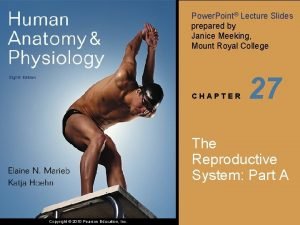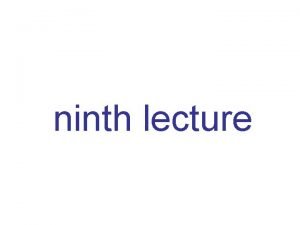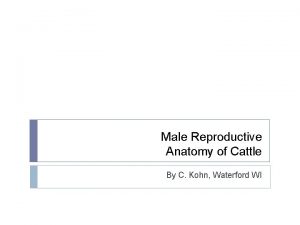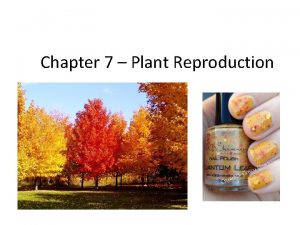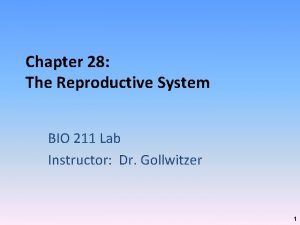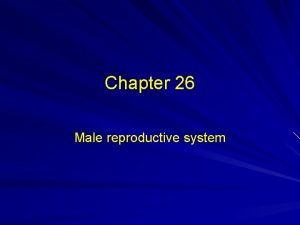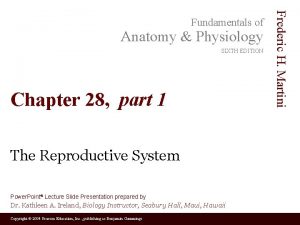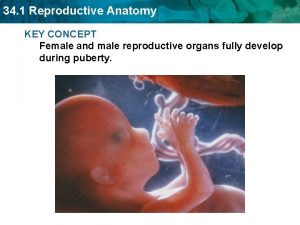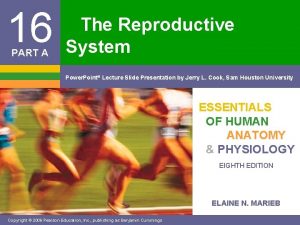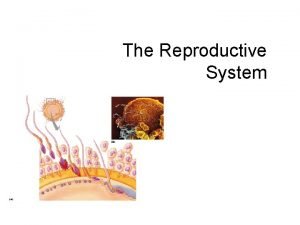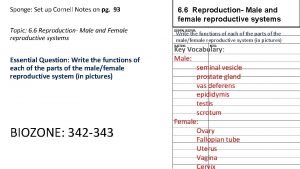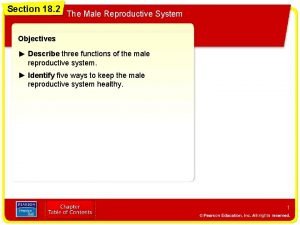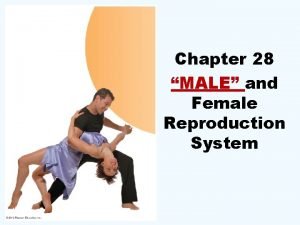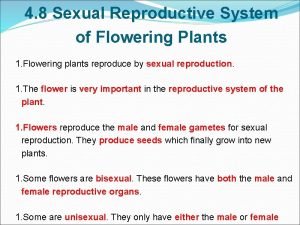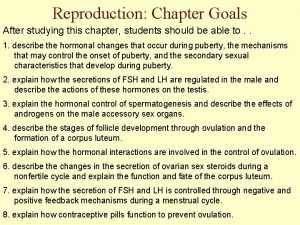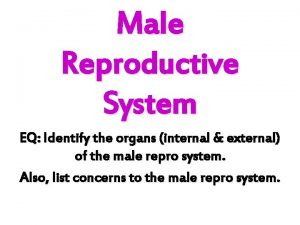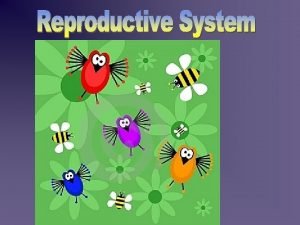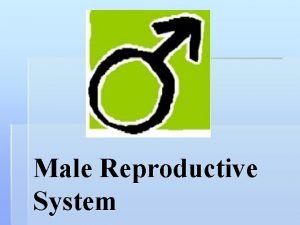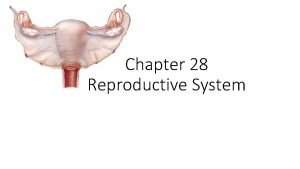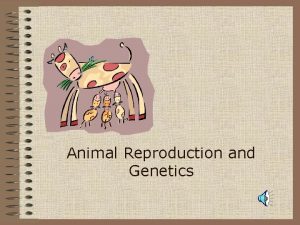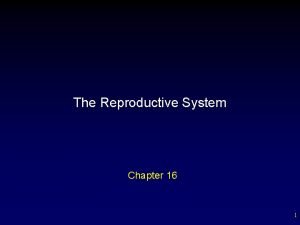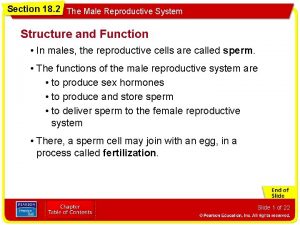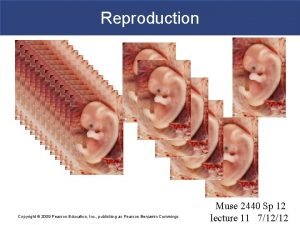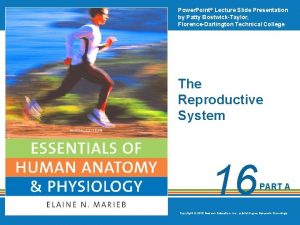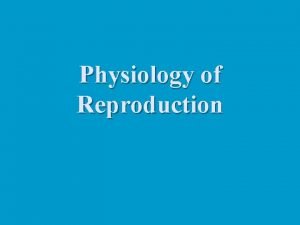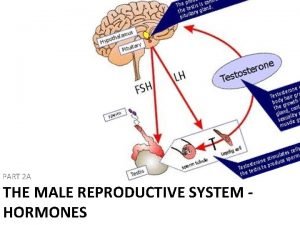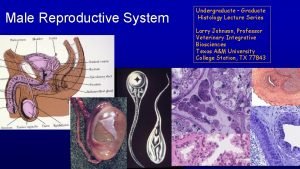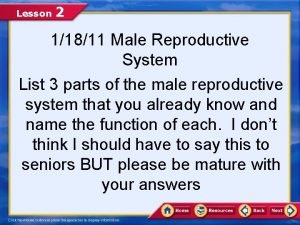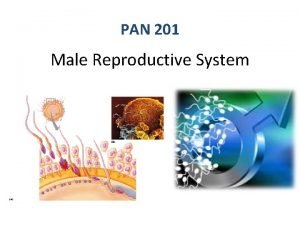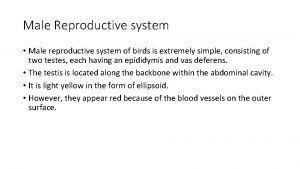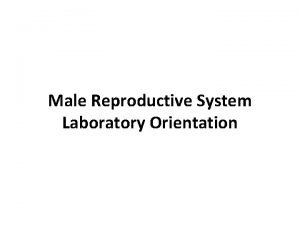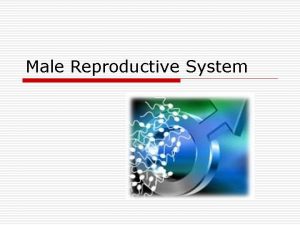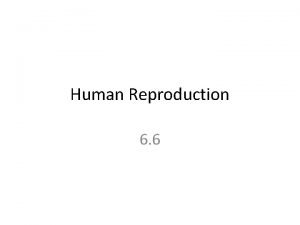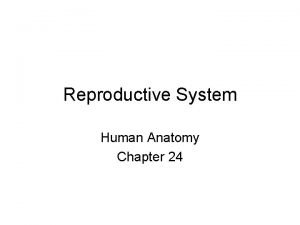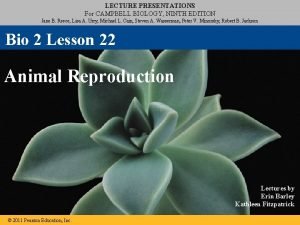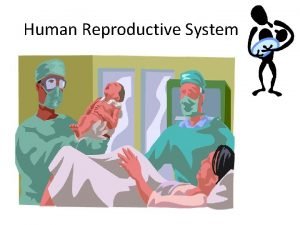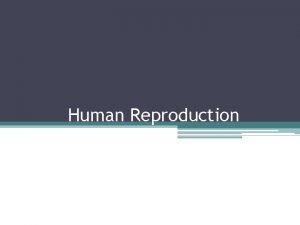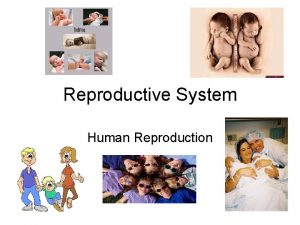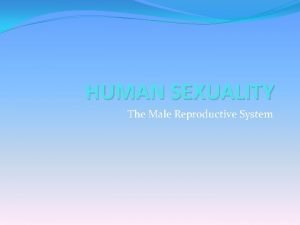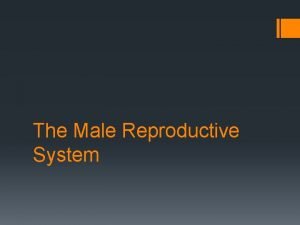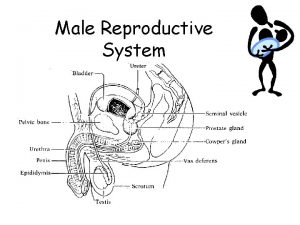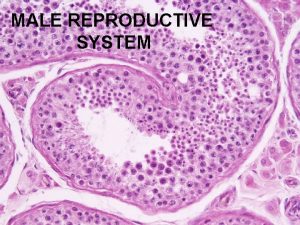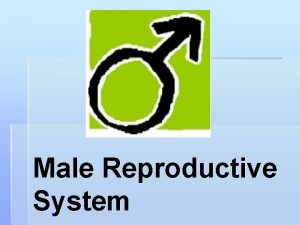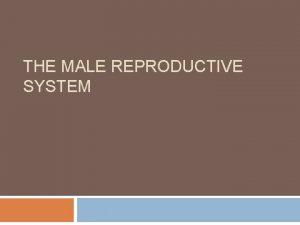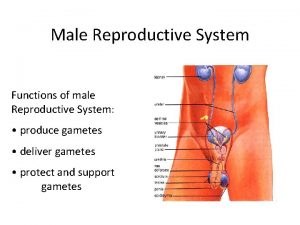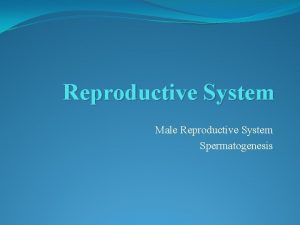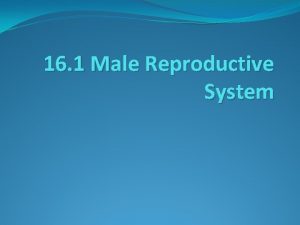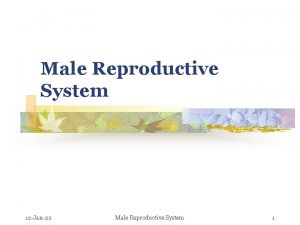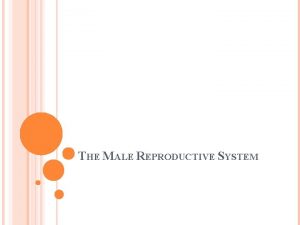Human Reproduction 1 The Male Reproductive System The



























![The female reproductive organs: [internal] • 1. vagina – Birth canal – Made up The female reproductive organs: [internal] • 1. vagina – Birth canal – Made up](https://slidetodoc.com/presentation_image_h/24cd1a67c6a001468e717cafa9e7447a/image-28.jpg)






![The female reproductive organs: [external] • • • 1. mons pubis 2. labia major The female reproductive organs: [external] • • • 1. mons pubis 2. labia major](https://slidetodoc.com/presentation_image_h/24cd1a67c6a001468e717cafa9e7447a/image-35.jpg)


![• The 2 main hormones folliclestimulating hormone[FSH] and luteinizing hormone[LH] are secreted from • The 2 main hormones folliclestimulating hormone[FSH] and luteinizing hormone[LH] are secreted from](https://slidetodoc.com/presentation_image_h/24cd1a67c6a001468e717cafa9e7447a/image-38.jpg)


















![What is PMS? • Premenstrual syndrome[PMS] refers to a variety of symptoms that women What is PMS? • Premenstrual syndrome[PMS] refers to a variety of symptoms that women](https://slidetodoc.com/presentation_image_h/24cd1a67c6a001468e717cafa9e7447a/image-57.jpg)






- Slides: 63

Human Reproduction 1

The Male Reproductive System • The male reproductive system has 2 main functions: – 1. Produces the male gametes[sperm] – 2. secretes the sex hormone testosterone 2

• The formation of sperm cells is called spermatogenesis • Sperm cells are highly specialized cells that are able to move 3

• the formation of sperm requires a temperature that is 2 to 4 degrees cooler than the body 4

Parts of the sperm cell • The head of the sperm is the haploid nucleus that has all the important genetic information 5

• The mid-piece has mitochondria that produce ATP which gives the sperm the energy it needs to reach the egg • The tail propels[moves] the sperm along 6

7

8

9

Parts of the male reproductive tract 1. Testes: • -located in the scrotum • -it’s where the production of sperm occurs 10

• -inside the testes are many tiny tubes called seminiferous tubules • - normal diploid cells move through these tubes while they undergo meiotic cell division 11

• 2. scrotum: – the sac that holds the testes – An adaptation of the male reproductive system that provides a lower temperature for the development of sperm cells is the scrotum 12

• 3. Epididymis: – this is where the sperms “live” and complete their development into mature sperm cells 13

4. vas deferens • -this is the beginning of the pathway for the sperm to exit out • - as the sperm moves through the vas deferens, it stops at 3 accessory sex glands to add fluids: 14

The 3 accessory sex glands • 1. Seminal vesicle – A pouch-like gland that secretes fluid that’s rich in fructose – Helps provide a source of energy for the sperm 15

• secretes prostaglandins[these are chemicals that cause contractions to help move the sperm toward the egg] 16

• 2. Prostate gland: • Secretes an anticoagulant enzyme called Prostate Specific Antigen (PSA) • PSA aids in the success of sperm by liquefying semen that has thickened after ejaculation. • This thinning action allows sperm to swim more freely 17

• 3. Cowper’s glands: – secretes alkaline PH; this neutralizes the acid in the male’s urethra and in the female reproductive system that might damage the sperm 18

• -sperm + fluids from the _______, ______ and the _____ is what makes up the semen 19

5. urethra • - tube that passes through the penis • - it’s a passage way for sperm and urine 20

6. penis • -a structure that has evolved to deposit sperm safely within the FEMALE’S body 21

• What causes an erection? • nerves in the brain send chemical messages to nerves in the penis telling the penile blood vessels to relax so that blood can flow freely into the penis. • This causes the penis to expand sustain an erection. 22

• Define ejaculation: the excretion of semen out of the penis 23

The female reproductive system • The female reproductive system has 3 important functions: – 1. oogenesis the production of ova – 2. provides a temporary “home” for the developing embryo – 3. produces estrogen and progesterone 24

• How do females produce their egg cells and at what age does this occur? 25

• The production of egg cells begins in a women’s body before she’s born • Millions of cells in the female fetus have already begun the 1 st phase of meiosis in the immature ovaries by the time of birth • When the female reaches puberty, a single egg is matured during meiosis 2 and released each month 26

27
![The female reproductive organs internal 1 vagina Birth canal Made up The female reproductive organs: [internal] • 1. vagina – Birth canal – Made up](https://slidetodoc.com/presentation_image_h/24cd1a67c6a001468e717cafa9e7447a/image-28.jpg)
The female reproductive organs: [internal] • 1. vagina – Birth canal – Made up of muscular tissue – Has elasticity – About 10 centimeters long 28

• 2. cervix – A narrow opening at the lower end of the uterus 29

• 3. uterus – a pear-shaped organ with thick muscular walls –Houses a developing fetus for 40 weeks 30

• Contracts during labor and childbirth –Where menstruation occurs 31

• 4. fallopian tubes 2 pair – Also called the oviducts or uterine tubes – A long tubular structure found next to each ovary – Egg travels through here during ovulation 32

–Fertilization occurs here –At the end of each tube are finger-like structures called fimbriae 33

• 5. ovary 2 pair –Houses the developing ova –Produces the female sex hormones 34
![The female reproductive organs external 1 mons pubis 2 labia major The female reproductive organs: [external] • • • 1. mons pubis 2. labia major](https://slidetodoc.com/presentation_image_h/24cd1a67c6a001468e717cafa9e7447a/image-35.jpg)
The female reproductive organs: [external] • • • 1. mons pubis 2. labia major 3. labia minor 4. clitoris 5. breast 35

36

Hormones and Sexual reproduction • The main endocrine gland in charge of producing these hormones is the…… • pituitary gland in the brain 37
![The 2 main hormones folliclestimulating hormoneFSH and luteinizing hormoneLH are secreted from • The 2 main hormones folliclestimulating hormone[FSH] and luteinizing hormone[LH] are secreted from](https://slidetodoc.com/presentation_image_h/24cd1a67c6a001468e717cafa9e7447a/image-38.jpg)
• The 2 main hormones folliclestimulating hormone[FSH] and luteinizing hormone[LH] are secreted from the anterior pituitary 38

• In males – FSH targets the testes and stimulates the seminiferous tubules to make sperm – LH targets the testes to produce testosterone 39

• What is the function of testosterone? • It plays a role in determining the gender of developing fetuses • Secondary Sex Characteristics • It contributes to an active sexual drive in both men and women • increases the metabolic functions in men • It is necessary for sperm to mature 40

• In females – FSH targets the ovaries and stimulates the development of the eggs[ova] – LH targets the ovaries and stimulates the estrogen and triggers ovulation 41

What is the function of estrogen and progesterone? • secondary sex characteristics • Responsible for ovulation • Responsible for the menstrual cycle 42

43

Menstrual cycle • Days 1 -13 Follicle phase – The egg is maturing in the ovaries • The ovaries contain follicles[a hollow bundle of cells with an egg inside] • The follicles help the egg mature • Several follicles begin to grow with each cycle, but usually one matures; the others disintegrate 44

• As the egg matures, the follicle enlarges and fills with fluid • The follicle releases estrogen which in turn stimulates the release of LH 45

46

• Day 14 Beginning of ovulation • This release of LH cause the follicle to move to the edge of the ovary and bursts • This releases the egg and the fluid into the oviduct[ovulation] 47

• in addition, estrogen causes the lining of the uterus to thicken and there’s an increase in the amount of blood that flows to this area 48

• days 15 -20 corpus luteum phase • ovulation still occurring • after ovulation has occurred the follicle[now without an egg cell] develops into a yellow-colored body[corpus luteum] 49

• the corpus luteum begins to secrete progesterone and further thickens the lining of the uterus including enlargement of arteries and growth of endometrial glands • These glands secrete a nutrient fluid that can sustain an early embryo even before it implants in the uterine lining 50

51

• days 21 -28 menstruation • the level of LH decreases • the corpus luteum breaks down 52

• level of progesterone decreases • The uterine lining disintegrates, releasing blood that is shed along with endometrial tissue and fluid 53

54

55

56
![What is PMS Premenstrual syndromePMS refers to a variety of symptoms that women What is PMS? • Premenstrual syndrome[PMS] refers to a variety of symptoms that women](https://slidetodoc.com/presentation_image_h/24cd1a67c6a001468e717cafa9e7447a/image-57.jpg)
What is PMS? • Premenstrual syndrome[PMS] refers to a variety of symptoms that women can experience 1 -10 days BEFORE her period 57

What are the symptoms of PMS? 58

What causes PMS? • Changes in hormone levels • Poor diet • Stress • Lack of exercise 59

Pelvic exam • Once a female turns 21 years old OR if she is sexually active, she should have regular pelvic exams 60

• After about 500 cycles, human females undergo menopause, the permanent end of ovulation and menstruation 61

What are the symptoms of menopause? 62

63
 Function of the vagina
Function of the vagina Male reproductive system and its function
Male reproductive system and its function Drawing of the male and female reproductive system
Drawing of the male and female reproductive system Exercise 42 review male reproductive system
Exercise 42 review male reproductive system Oogenesis
Oogenesis Broad ligament of uterus
Broad ligament of uterus What is reproductive system
What is reproductive system Figure 16-1 is a sagittal view of the male reproductive
Figure 16-1 is a sagittal view of the male reproductive Reproductive physiology
Reproductive physiology Human reproductive system
Human reproductive system Art-labeling activity: the male reproductive system, part 1
Art-labeling activity: the male reproductive system, part 1 Male reproductive system information
Male reproductive system information Where semen is stored
Where semen is stored Bull reproductive system parts and functions
Bull reproductive system parts and functions Prosted
Prosted Asexual reproduction
Asexual reproduction Function of male reproductive system
Function of male reproductive system Fish reproductive system
Fish reproductive system Reproduction in pila
Reproduction in pila Bladder fetal pig
Bladder fetal pig Female part of a flower
Female part of a flower Figure 28-2 the female reproductive system
Figure 28-2 the female reproductive system Base of prostate gland
Base of prostate gland Lesson 20.2 the male reproductive system
Lesson 20.2 the male reproductive system Cow male reproductive system
Cow male reproductive system Figure 28-2 the female reproductive system
Figure 28-2 the female reproductive system Colon function in male reproductive system
Colon function in male reproductive system Figure 16-1 male reproductive system
Figure 16-1 male reproductive system Similarities between male and female reproductive system
Similarities between male and female reproductive system Male reproductive system labeled
Male reproductive system labeled Pathway of semen
Pathway of semen 90/2
90/2 Male plant reproductive system
Male plant reproductive system Summary of reproductive system
Summary of reproductive system Womans anatomy
Womans anatomy V
V What is seminal vesicle in male reproductive system
What is seminal vesicle in male reproductive system Oogenesis diagram
Oogenesis diagram Semen
Semen Penis glans
Penis glans Male reproductive system of mammals
Male reproductive system of mammals Chapter 16 lesson 2 the male reproductive system
Chapter 16 lesson 2 the male reproductive system Anatomy of the human ovary
Anatomy of the human ovary Male reproductive system side view
Male reproductive system side view Male reproductive system
Male reproductive system Figure 28-1 the male reproductive system
Figure 28-1 the male reproductive system Figure 16-1 male reproductive system
Figure 16-1 male reproductive system Oocyte
Oocyte Male reproductive system table
Male reproductive system table Primary spermatocyte
Primary spermatocyte Lesson 2: the male reproductive system
Lesson 2: the male reproductive system Epididymiis
Epididymiis Male reproductive system of birds
Male reproductive system of birds Trabecula
Trabecula Male reproductive system
Male reproductive system Male reproductive system
Male reproductive system Asexual reproduction cell division
Asexual reproduction cell division Sexual reproduction and asexual reproduction
Sexual reproduction and asexual reproduction Venn diagram of sexual and asexual reproduction in animals
Venn diagram of sexual and asexual reproduction in animals Gandotropin
Gandotropin Oogonium
Oogonium What produces pollen grains
What produces pollen grains Fertilization occurs
Fertilization occurs Reproduction in humans
Reproduction in humans










